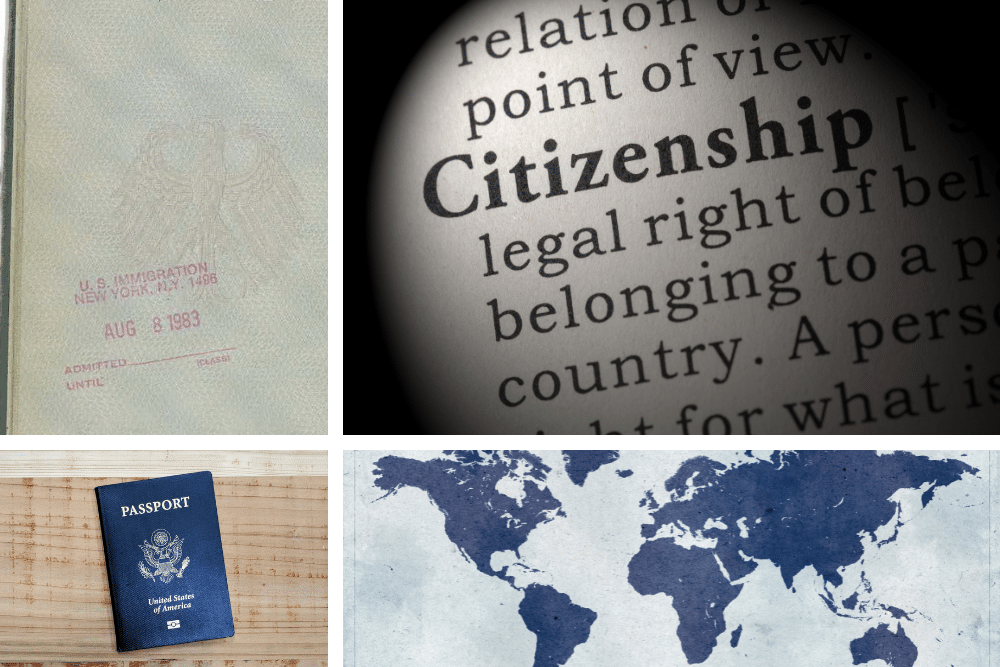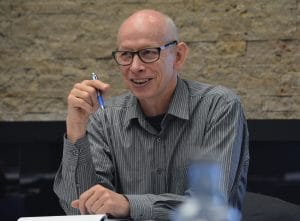*Editor’s Note: The “Views from NAU” blog series highlights the thoughts of different people affiliated with NAU, including faculty members sharing opinions or research in their areas of expertise. The views expressed reflect the authors’ own personal perspectives.
 By Björn Krondorfer
By Björn Krondorfer
Regents’ professor in the Department of Comparative Cultural Studies and director of the Martin-Springer Institute
Dr. Björn Krondorfer studies religion, gender and culture and post-Holocaust and reconciliation studies; his scholarship helped define the field of critical men’s studies in religions. He is the author of Unsettling Empathy: Working with Groups in Conflict, Reconciliation in Global Context: Why it is Needed and How it Works and Remembrance and Reconciliation, among many other works.
The date stamped in my now-defunct German passport reads, “U.S. Immigration, New York, NY, August 8, 1983.” That day, I took my first step on U.S. soil to start a one-year graduate study program in Philadelphia. Little did I know I would still be in America 40 years later. That was not how I imagined my life to turn out—an experience, I think, many people share who arrive on America’s shores and stay.
When I watched Oppenheimer in a Flagstaff movie theater this summer—the biopic about the creation of the first atomic bomb near Alamo, New Mexico—the memory of arriving in New York in 1983 resurfaced. Back then, I was fully aware of Aug. 8 being sandwiched between the anniversary of the atomic bombing of Hiroshima and Nagasaki, on Aug. 6 and 9, respectively. Many young Germans at the time were involved in anti-nuclear protests, opposing the planned installation of the Pershing II rockets at American military installations in Germany, capable of carrying thermonuclear warheads. The Cold War was still in full swing. When I got to Philadelphia, I was flummoxed by the apathy among Americans I met regarding the nuclear threat. It felt as if I were betraying my politically engaged friends back home. I would only be here for one year, I comforted myself. That was 40 years ago, and today we are alerted anew to the specter of nuclear war in light of Putin’s saber-rattling and China and North Korea’s growing nuclear arsenals.
Forty is a number of biblical proportions, signaling a long time of wandering and wondering. The tired metaphor of a “promised land” may suggest itself when looking back at all these years, but it is really about the constant moving without ever fully arriving that marks the experience of many migrants. I came voluntarily from Europe, not forced to leave, not brown-skinned, not persecuted, not poor and without options. Yet, settling in a new country is always a struggle. It is the exhaustive work of constantly deciphering codes, living vulnerably, learning to adjust and slowly metamorphizing into new, untested selves.
At first, there are language issues. In retrospect, they are funny, like asking my American hosts the first night in Philadelphia whether I can “have a douche,” believing that this is the equivalent for the German word “Dusche,” for taking a shower. Their irritated look, then laughter, left me dumbfounded. Plenty of those moments. At the Ph.D. defense seven years later, my friends congratulated me for finally speaking English.
Then there are identity issues. When arriving in 1983, I thought of myself as “Björn,” an individual who happened to have grown up in Germany. As Björn, I explored my new environment. I registered for an African dance class (as the only man and only white person), then a small Jewish modern dance ensemble (as the only non-Jew). I did not think much of it at the time. I soon met and mingled with Holocaust survivors and their descendants, and I became “German.” Who I was as an individual mattered only to the extent that I was able to account for German history and, particularly, for my family history. “What did your grandparents do? Who are your parents?” I knew embarrassingly little. Reckoning with Germany’s lethal past, and locating myself within it, turned out to be a hard but necessary and rewarding lesson.
While the process of becoming “German” happened early on, it took longer to become “white.” As strange as this may sound today, in the 1980s I was both colorblind and hyperaware of America’s race-based classifications, yet I moved easily in and out of different communities. As soon as I opened my mouth, Black Americans on the East Coast related to me as a “German” guest (often because of their overall positive experiences serving in the U.S. armed forces in Germany). It seemed uncomplicated. However, living in this country for long, I eventually became “white,” a process neither willed nor wanted. It is not forced upon you, but the codes that signify racial divisions are inescapable and powerful social dynamics. We notice them when encounters unexpectedly turn knotty, when choosing words carefully, when being pushed into modes of behavioral caution we don’t agree with but can’t escape.
It takes a generation and more to find “home” again. It is the next generation that signifies most clearly this change—and that is perhaps the secret of the 40 years of wandering. It is the next generation that truly arrives. The moment my daughters were born in this country, I realized the profound change. They could become “Americans” in a way I never would. It was my professional self that kept me here, now directing a center at NAU founded by a Polish-Jewish Holocaust survivor. There is an irony in all of this, especially given the fact that my father had been stationed as a young soldier in Hitler’s army in 1944 in a region close to where Doris Martin, the founder of NAU’s Martin-Springer Institute, survived in a forced labor camp for Jewish women.
There were moments when I regretted not being in Germany, like witnessing in person the fall of the Berlin Wall in 1989, which heralded the end of the Cold War, holding out the promise of a diminished nuclear threat. At some point I stopped reading German newspapers on a regular basis and began to “read” the world through the reporting of trustworthy U.S. outlets. I legally became an American citizen the year Obama was elected the first black president of the United States. It was good to regain political agency. When I accepted the director position at the Martin-Springer Institute in 2012, I moved closer to the geography of Oppenheimer, the test site in New Mexico. Living in the Southwest made me more aware of what the movie does not show: the Indigenous people who worked in the uranium mines, those who lived in areas affected by the nuclear fallout, the minority populations who built and maintained Alamo, Japanese-American internment camps in the Southwest and the victims of the bombing in Japan itself.
For a long time, I felt that if things go really wrong in the United States, I can return to Europe. Today, I don’t think any more of this escape route, though I deeply worry about the future of my adopted home. And this includes the amplification of antisemitic sentiments and actual hate acts, something that seemed inconceivable in 1983 in a country that compelled me to take a deep, sobering look at the shameful history of the country of my birth.
I am here now. I appreciate NAU’s renewed commitment to acknowledging and celebrating diversity. But when I enter a store in Flagstaff, say hello and am asked, “Where are you from?” I know it is still a journey, an ever-suspended, not-quite-yet arrival.




 By Björn Krondorfer
By Björn Krondorfer